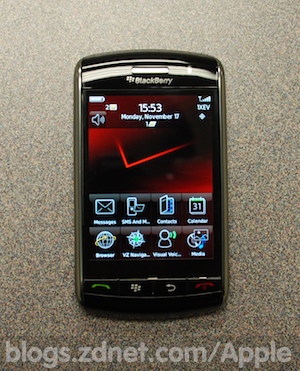More iPhone vs. Storm: Comparing component costs

There's some buzz today about an iSuppli report that dove deep into an analysis of component costs for the Blackberry Storm, compared to a similar breakdown of Apple's iPhone. In the end, the electronics research firm found that the cost of components and manufacturing cost about $203, compared to Apple's costs of less than $175.

Before anyone starts multiplying the $28 or so difference between the component and manufacturing costs to figure out how much cash Apple (and RIM) are making on these devices, consider the iSuppli caveat: the estimates only look at component and assembly costs. They don't take into account the software, patent licensing or distribution costs. I also didn't see where it took into account the battery.
In a post yesterday, I wrote about how I ended up taking back my iPhone (blaming the poor AT&T voice service) and buying a Storm instead. One of the tidbits of information I left out was the battery issue. The iPhone couldn't keep a charge to save its life - and the best advice I was given by other iPhone users was to turn off the 3G connection to help reduce the drain on the battery. Seriously.
I don't know what the locked-in battery on an iPhone costs and whether that was a penny-pinching item over at Apple. iSuppli gave the exclusive advance interview about the Storm analysis report to Business Week and, as of Thursday morning, hasn't officially released its report so I could do my own digging.
I recognize the whole bit about lowering component prices and beefing up profit margins. And I also get that, given the hype and lovefest that's surrounding the iPhone, Apple really has no incentive to make any significant changes. AT&T appears to be happy. Apple is moving up and closing the gap on RIM, which had a decade head-start in what is now called the smartphone business. And consumers, even if they have issues with the battery, are willing to turn off the 3G connection or make other sacrifices just to keep that iPhone in-hand.
One other note about the iSuppli report and the Business Week piece. The magazine reports that the Storm uses a $35 chip from Qualcomm that allows it to work on both GSM-GPRS networks (AT&T and T-Mobile) and CDMA (Verizon and Sprint) while the iPhone only works on GSM-GPRS. That means that RIM can sell to all the major carriers while Apple cannot. Imagine the iPhone world domination (and potential app store revenue) if Apple made the iPhone compatible on all networks. I'd buy one again. (Remember, I liked the iPhone A LOT. I hated the AT&T service.)
Take that $35 out of the equation and suddenly the component cost of the Storm is less than the iPhone (at least based on the data points we know about.)
I'm glad that firms like iSuppli are doing the deep analysis of these products. But without the full picture - the costs of software, licensing and distribution - it's misleading to draw any definitive conclusions.
The folks at iSuppli said they will send me the details of the research when they're available - presumably, today. If there's anything worth noting or if I've missed some sort of critical piece of information, I'll definitely update this post.